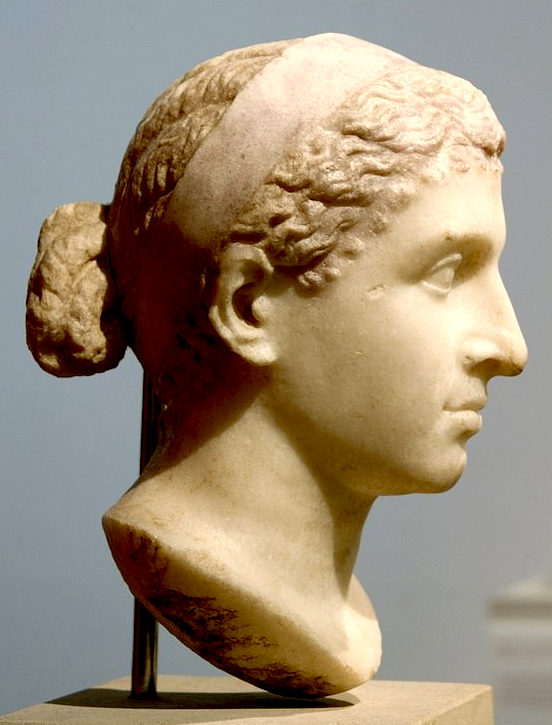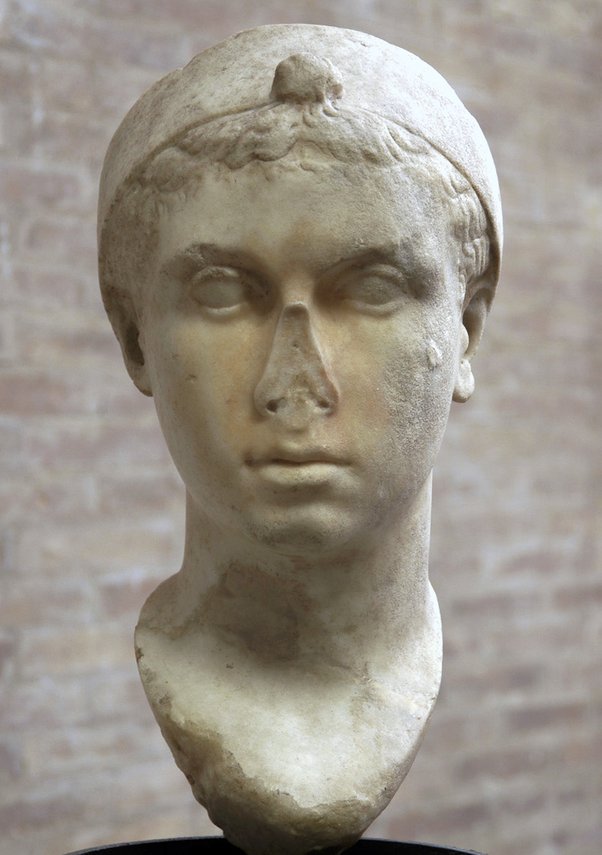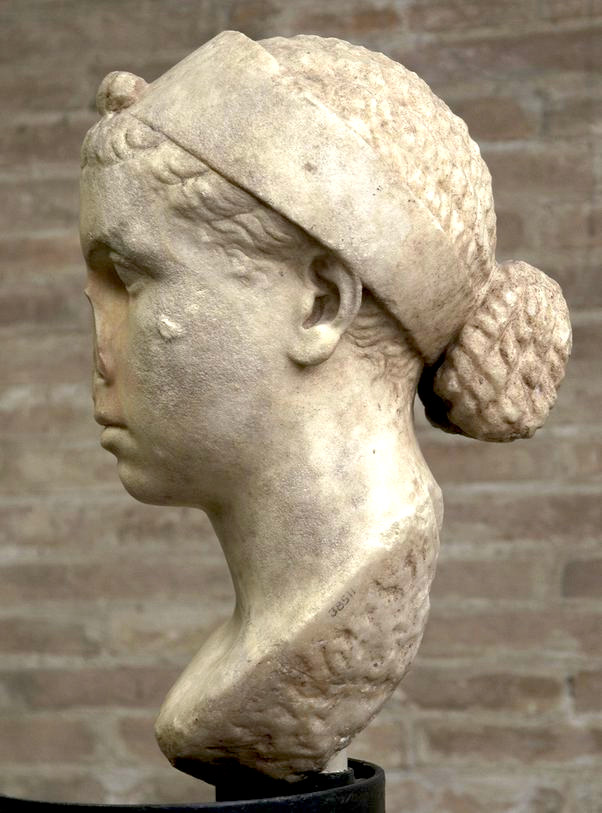|
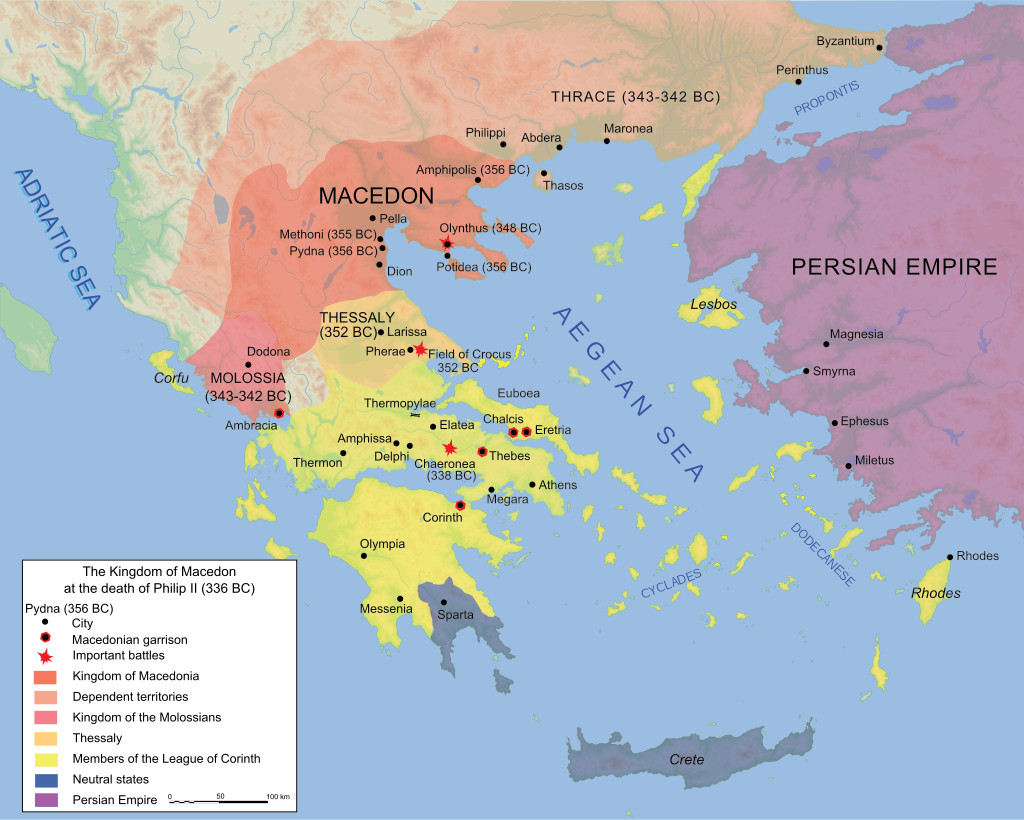
Map
showing Macedonia, Persian Empire and Thrace 365BC
For a brief period,
the Macedonian Empire was the most powerful in the world – the definitive Hellenistic state, inaugurating the transition to a new period of Ancient Greek civilization.
Macedonia, also called Macedon, was an ancient kingdom on the periphery of Archaic and Classical Greece, which later became the dominant state of Hellenistic Greece. The kingdom was founded and initially ruled by the royal Argead dynasty, which was followed by the Antipatrid and Antigonid dynasties.
Before the 4th century BC, Macedonia was a small kingdom outside of the area dominated by the great city-states of Athens, Sparta and Thebes, and briefly subordinate to Achaemenid Persia. During the reign of the Argead king Philip II (359–336 BC), Macedonia subdued mainland Greece and the Thracian Odrysian kingdom through conquest and diplomacy. With a reformed army containing phalanxes wielding the sarissa pike, Philip II defeated the old powers of Athens and Thebes in the Battle of Chaeronea in 338 BC. Philip II's son Alexander the Great, leading a federation of Greek states, accomplished his father's objective of commanding the whole of Greece when he destroyed Thebes after the city revolted. During Alexander's subsequent campaign of conquest, he overthrew the Achaemenid Empire and conquered territory that stretched as far as the Indus River.
After Alexander's death in 323 BC, the ensuing wars of the Diadochi, and the partitioning of Alexander's short-lived empire, Macedonia remained a Greek cultural and political center in the Mediterranean region along with Ptolemaic Egypt, the Seleucid Empire, and the Attalid kingdom. Important cities such as Pella, Pydna, and Amphipolis were involved in power struggles for control of the territory. New cities were founded, such as Thessalonica by the usurper Cassander (named after his wife Thessalonike of Macedon). Macedonia's decline began with the Macedonian Wars and the rise of Rome as the leading Mediterranean power. At the end of the Third Macedonian War in 168 BC, the Macedonian monarchy was abolished and replaced by Roman client states. A short-lived revival of the monarchy during the Fourth Macedonian War in 150–148 BC ended with the establishment of the Roman province of Macedonia.
The Macedonian kings, who wielded absolute power and commanded state resources such as
gold and
silver, facilitated mining operations to mint currency, finance their armies and, by the reign of Philip II, a Macedonian navy. Unlike the other diadochi successor states, the imperial cult fostered by Alexander was never adopted in Macedonia, yet Macedonian rulers nevertheless assumed roles as high priests of the kingdom and leading patrons of domestic and international cults of the Hellenistic religion.
HELLENISTIC GREECE
Hellenistic Greece is the historical period of the country following Classical Greece, between the death of Alexander the Great in 323
BC and the annexation of the classical Greek Achaean League heartlands by the Roman Republic. This culminated at the Battle of Corinth in 146 BC, a crushing Roman victory in the Peloponnese that led to the destruction of Corinth and ushered in the period of Roman Greece. Hellenistic Greece's definitive end was with the Battle of Actium in 31 BC, when the future emperor Augustus defeated Greek Ptolemaic queen Cleopatra VII and Mark Antony, the next year taking over Alexandria, the last great center of Hellenistic Greece.
The Hellenistic period began with the wars of the Diadochi, armed contests among the former generals of Alexander the Great to carve up his empire in Europe, Asia, and North Africa. The wars lasted until 275 BC, witnessing the fall of both the Argead and Antipatrid dynasties of Macedonia in favor of the Antigonid dynasty. The era was also marked by successive wars between the Kingdom of Macedonia and its allies against the Aetolian League, Achaean League, and the city-state of Sparta.
During the reign of Philip V of Macedon (r. 221–179 BC), the Macedonians not only lost the Cretan War (205–200 BC) to an alliance led by Rhodes, but their erstwhile alliance with Hannibal of Carthage also entangled them in the First and Second Macedonian War with ancient Rome. The perceived weakness of Macedonia in the aftermath of these conflicts encouraged Antiochus III the Great of the Seleucid Empire to invade mainland Greece, yet his defeat by the Romans at Thermopylae in 191 BC and Magnesia in 190 BC secured Rome's position as the leading military power in the region. Within roughly two decades after conquering Macedonia in 168 BC and Epirus in 167 BC, the Romans would eventually control the whole of Greece.
During the Hellenistic period the importance of Greece proper within the Greek-speaking world declined sharply. The great centers of Hellenistic culture were Alexandria and Antioch, capitals of Ptolemaic
Egypt and Seleucid Syria respectively. Cities such as Pergamon, Ephesus, Rhodes and Seleucia were also important, and increasing urbanisation of the Eastern Mediterranean was characteristic of the time.
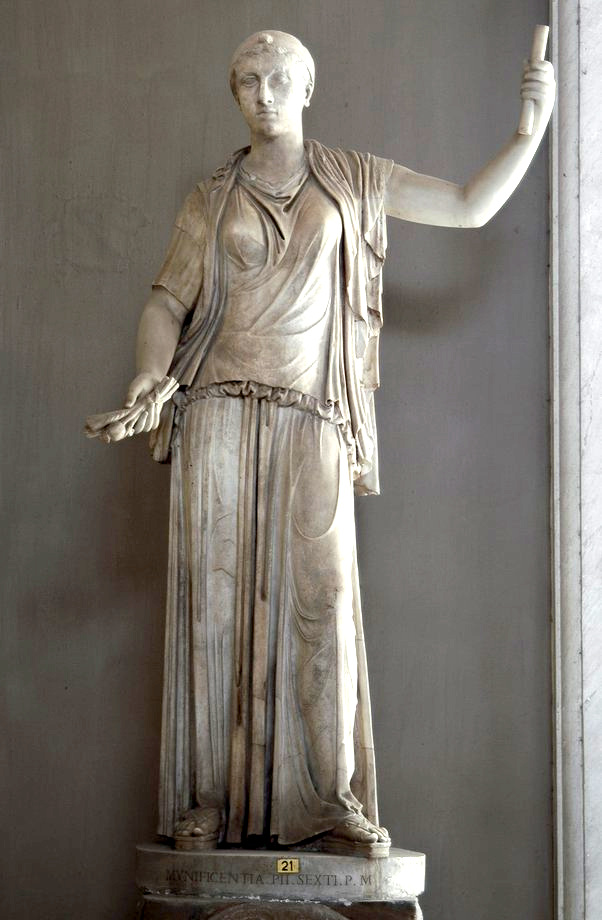
A
statue of Cleopatra VII at the Vatican Museum
MACEDONIAN WARS
The Macedonian Wars (214–148 BC) were a series of conflicts fought by the Roman Republic and its Greek allies in the eastern Mediterranean against several different major Greek kingdoms. They resulted in Roman control or influence over Greece and the rest of the eastern Mediterranean basin, in addition to their hegemony in the western Mediterranean after the Punic Wars. Traditionally, the "Macedonian Wars" include the four wars with Macedonia, in addition to one war with the Seleucid Empire, and a final minor war with the Achaean League (which is often considered to be the final stage of the final Macedonian war). The most significant war was fought with the Seleucid Empire, while the war with Macedonia was the second, and both of these wars effectively marked the end of these empires as major world powers, even though neither of them led immediately to overt Roman domination. Four separate wars were fought against the weaker power, Macedonia, due to its geographic proximity to Rome, though the last two of these wars were against haphazard insurrections rather than powerful armies. Roman influence gradually dissolved Macedonian independence and digested it into what was becoming a leading empire. The outcome of the war with the now-deteriorating Seleucid Empire was ultimately fatal to it as well, though the growing influence of Parthia and Pontus prevented any additional conflicts between it and Rome.
From the close of the Macedonian Wars until the early Roman Empire, the eastern Mediterranean remained an ever shifting network of polities with varying levels of independence from, dependence on, or outright military control by, Rome. According to Polybius, who sought to trace how Rome came to dominate the Greek east in less than a century, Rome's wars with Greece were set in motion after several Greek city-states sought Roman protection against the Macedonian Kingdom and Seleucid Empire in the face of a destabilizing situation created by the weakening of Ptolemaic Egypt.
In contrast to the west, the Greek east had been dominated by major empires for centuries, and Roman influence and alliance-seeking led to wars with these empires that further weakened them and therefore created an unstable power vacuum that only Rome was capable of pacifying. This had some important similarities (and some important differences) to what had occurred in Italy centuries earlier, but was this time on a continental scale. Historians see the growing Roman influence over the east, as with the west, not as a matter of intentional empire-building, but constant crisis management narrowly focused on accomplishing short-term goals within a highly unstable, unpredictable, and inter-dependent network of alliances and dependencies. With some major exceptions of outright military rule (such as parts of mainland Greece), the eastern
Mediterranean world remained an alliance of independent city-states and kingdoms (with varying degrees of independence, both de jure and de facto) until it transitioned into the Roman Empire. It wasn't until the time of the Roman Empire that the eastern Mediterranean, along with the entire Roman world, was organized into provinces under explicit Roman control.
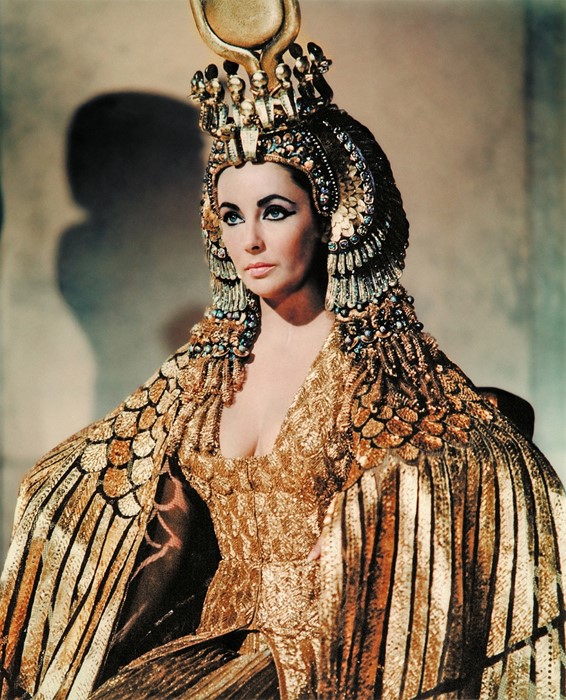
CLEOPATRA OF MACEDON
Cleopatra of Macedonia (c. 355/354 BC – 308 BC), or Cleopatra of Epirus (Greek: Κλεοπάτρα της Ηπείρου) was an ancient Macedonian princess and later queen regent of Epirus. The daughter of Philip II of Macedon and Olympias of Epirus, she was the only full sibling of Alexander the Great. Her other siblings include half sisters Thessalonike and Cynane, and half-brother Philip III of Macedon.
Cleopatra ruled Epirus in the meantime. It was an Epirote custom that the woman of a family became head of household when her husband died and their son(s) were too young, unlike the rest of Greece. Notably, an embassy from Athens was dispatched to deliver condolences upon her husband's death. While, Alexander the Great expressed uncertainty about the Macedonians being willing to be reigned by a woman, most sources highlight his endorsement of Cleopatra's agency.
Cleopatra seemingly acted as the religious head of state for the people of Molossia. Her name appears on a list of Theorodokoi("welcomers of sacred ambassadors"), in the recently established Epirote alliance. Cleopatra was significantly the only woman on the list. Her position as official welcomer would have allowed her to keep a finger on whatever was happening anywhere in Greece. Cleopatra may also have been instrumental in implementing her brother's policies regarding grain shipments.
Cleopatra's personal life during this time is not recorded, though Plutarch wrote that Alexander commented that Cleopatra should have some enjoyment out of her basileia when he learned of an affair she had with a handsome young man.
Cleopatra's hand was sought in marriage by several of his generals, who thought to strengthen their influence with the Macedonians by a connection with the sister of Alexander the Great. Leonnatus is first mentioned as putting forward a claim to her hand, telling Eumenes that he received a lettered promise of marriage if he came to Pella. Cleopatra had extended her hand because she knew Leonnatus had the ambition and ability to overthrow the new mentally unfit king Philip III of Macedon. Meanwhile Leonnatus, before he arrived for the wedding and in an attempt to enhance his claim to the throne, stopped to lift the siege from the rebellious Greeks in Lamia and rescue Antipater. However he was killed in this action, so the marriage never occurred.
In 308BC, Cleopatra acceded to a proposal of marriage from Ptolemy and fled Sardis. However, before their marriage, she was captured, brought back to Sardis, and assassinated by one of her female attendants, reputedly by order of Antigonus. Despite afterwards executing the assassins and giving her a beautiful funeral in her honor, he knew she represented too much power to remain alive.
Cleopatra VII, would have known of these happenings, presumably, the history of political murders, shaping her ambitions, in formulating ways to survive the turmoil of the
times she live in.
IS CLEOPATRA VII GREEK-MACEDONIAN?
Cleopatra VII was the last active ruler of the Ptolemaic Kingdom of Egypt, which was founded by one of the generals of
Alexander the Great after his death. She was a member of the Ptolemaic dynasty, which was of Macedonian Greek origin and spoke Greek as their native language.
However, Cleopatra VII may have also had some Egyptian and Iranian ancestry through her mother, Cleopatra V Tryphaena, who was possibly a descendant of a concubine of Ptolemy I Soter, the founder of the dynasty. The identity and ethnicity of Cleopatra’s mother is not certain, but some scholars have suggested that she was either a native Egyptian or a Persian princess from the Sogdian region.
To sum up: it is quite possible that Cleopatra VII was pure Macedonian Greek. But it is probable that she had some Egyptian blood, although the amount is uncertain. Certainly it was no more than half, and probably less. The best evidence is that she was three-quarters Macedonian Greek and one-quarter Egyptian.
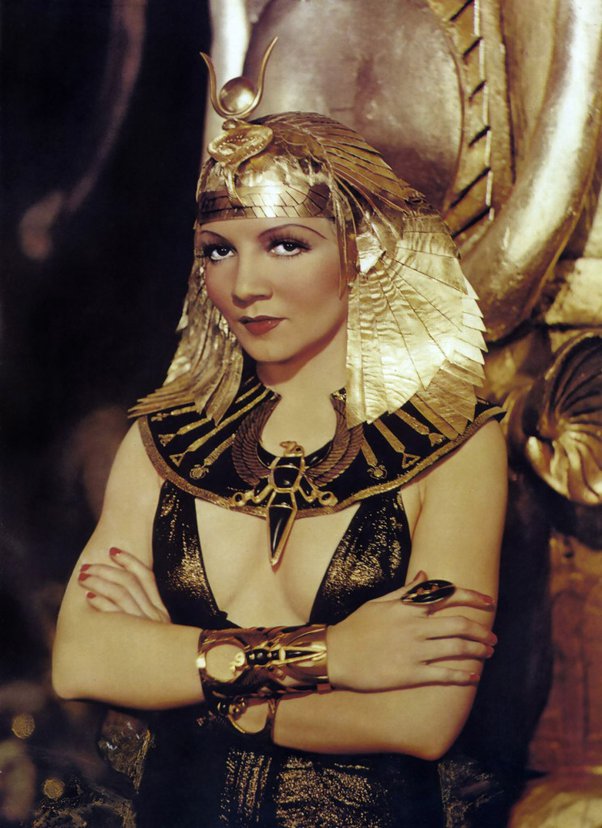
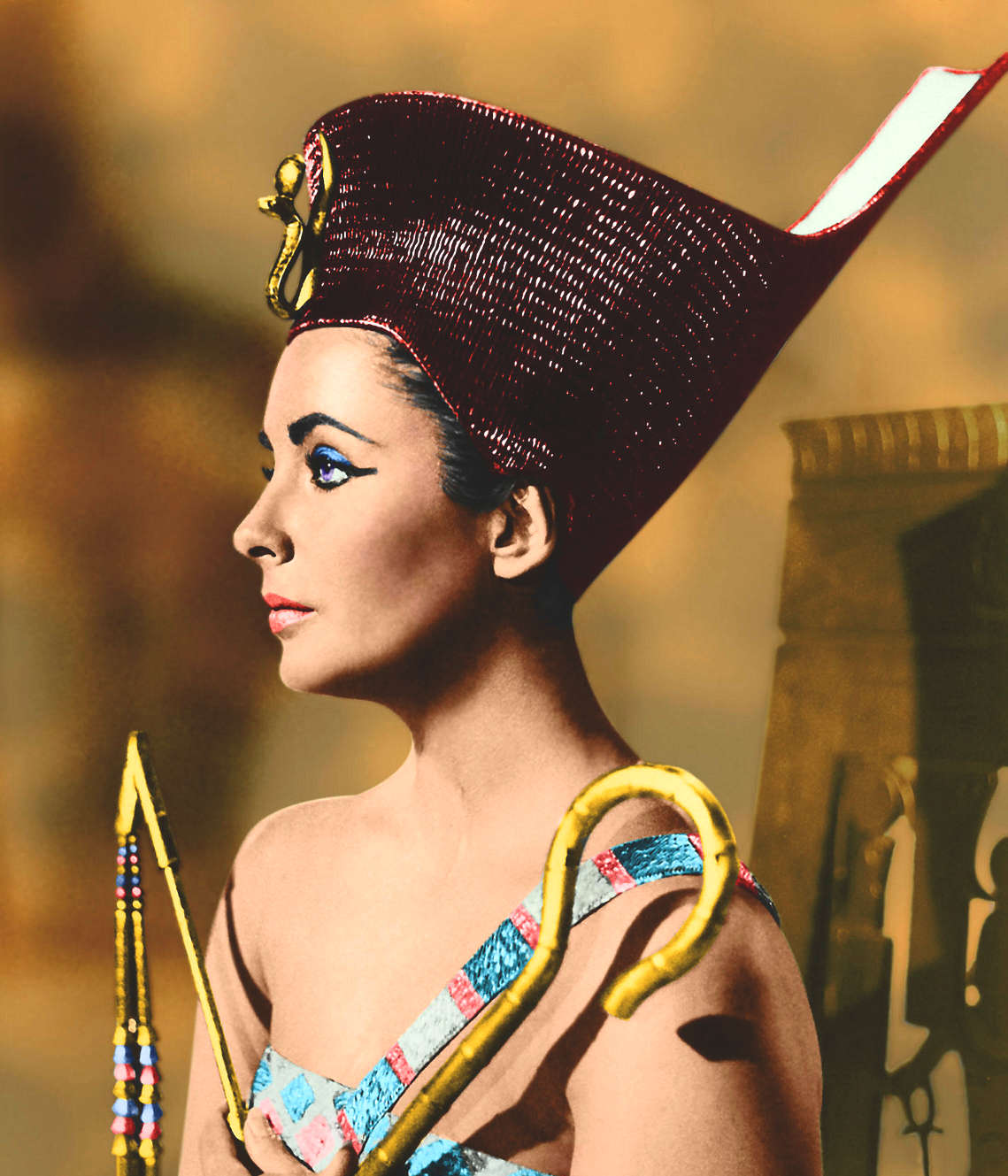
According to the web search results, the most likely mother of Cleopatra VII was Cleopatra V Tryphaena, who was also the sister and wife of Ptolemy XII Auletes1. However, her identity and fate are uncertain, and some sources suggest that she may have been another woman or that she died before Cleopatra VII was born. Cleopatra VII was the last active ruler of the Ptolemaic Kingdom of Egypt and a descendant of Ptolemy I Soter, a Macedonian Greek general and companion of Alexander the Great. She is famous for her political alliances and romantic relationships with Julius Caesar and Mark Antony, as well as her tragic death by snakebite. The classic version as to her poisoning.
POPULAR MISCONCEPTIONS
Perhaps the greatest misconception of all about Cleopatra, though, is what she looked like. Modern people have a very clear image of what Cleopatra looked like: a beautiful, pale, small-nosed woman like
Elizabeth Taylor dressed in a revealing outfit with thick makeup, straight, black hair, bangs, and braids with gold ornaments going down to her shoulders. Unfortunately for fans of classic films, this image is inaccurate in almost every single way.
We actually have pretty good idea of what the historical Cleopatra looked like and it’s nothing at all like the image most people have in mind. For one thing, she didn’t have bangs. She did have a large, hooked nose, a prominent chin, and curly hair that she normally wore in a bun at the back of her head. There’s even a possibility that she may have been a redhead.
We know very little about where the ancestors of most specific individuals who lived in Hellenistic and Roman Egypt came from. We have no idea whether Hypatia of Alexandria’s ancestors were mostly Greek or mostly Egyptian; all we know is that Hypatia herself lived in Alexandria, a city in northern Egypt that was founded by Greeks.
Cleopatra is one of the few exceptions to this trend. Because Cleopatra was a member of the well-documented and long-lasting Ptolemaic Dynasty, we have a pretty good impression of where most of her ancestors came from, going back centuries before she was even born. The fact is, nearly all of Cleopatra’s known ancestors were Makedonian Greeks whose ancestral homeland was the kingdom of Makedonia, which was located in what is now northern Greece.
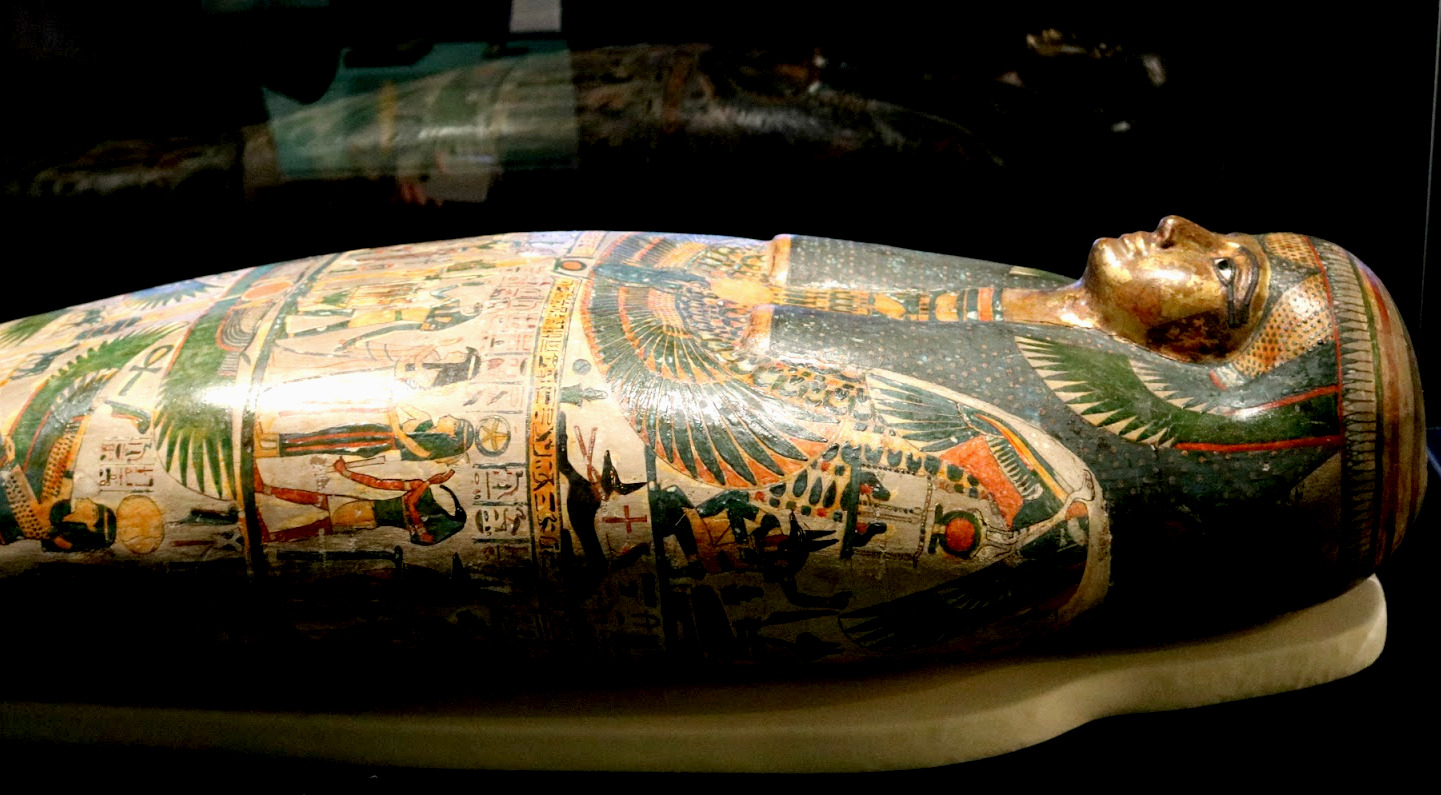
INCEST
As a member of the Ptolemaic Dynasty, Cleopatra was directly descended from Ptolemaios I
Soter, one of Alexander the Great’s generals and a member of the
Diadochoi, the group of generals who divided up Alexander’s empire amongst themselves. The Ptolemies were one of the most notoriously inbred dynasties in the ancient world and it was customary for men in the royal family, especially kings, to marry their own sisters and cousins.
The Ptolemies rarely ever married outsiders and, when they did, they usually only married members of other Greek royal families. In fact, Cleopatra’s only known ancestor with any non-Greek ancestry was her three times great-grandmother Kleopatra I of Syria, whose father Antiochos III was descended from
Apama, the Sogdian wife of the Greek king Seleukos I Nikator, and whose mother Laonike III was of mixed Greek and Persian ancestry.
As a result of all the rampant inbreeding, Cleopatra’s family tree looks a lot more like a ladder than a “tree.” Cleopatra herself married two of her own brothers in succession: Ptolemaios XIII Theos Philopator and Ptolemaios XIV. Both of these marriages ended badly.
In addition to being of Greek ancestry, the Ptolemies were also culturally Greek. Greek was the only language that most of the Ptolemies ever learned to speak and, while they portrayed themselves as pharaohs to their Egyptian subjects, they portrayed themselves to the
world - and almost certainly thought of themselves - as thoroughly Greek monarchs.
They minted Greek-style coins, sponsored Greek intellectuals, gave their offspring Greek names, commissioned portraits of themselves using Greek iconography, and traced their legitimacy to their connection with Alexander the Great.
In fact, Cleopatra herself was the only member of her family who ever even learned to speak the Egyptian language and, even with her, surviving documents from her court reveal that she conducted nearly all official business in Greek. She almost certainly would have thought of herself primarily as a Greek queen.
Cleopatra
VII had a Greek/Roman nose, even if these busts were regularized,
it is remarkable that different artists would interpret her
visage more of less identically.
WHAT
DID CLEOPATRA LOOK LIKE? Cleopatra’s father was
Ptolemaios XII
Auletes, but we don’t know for certain who her mother was. Ptolemaios XII is known to have had several wives, all of whom are reported to have been from noble families. His primary wife was Kleopatra V Tryphaina and she is the only one of his wives whose name is recorded.
The Greek writer Strabon of Amaseia (lived c. 64 BC – c. 24 AD) writes in his Geographika 17.1.11 that, of all Ptolemaios XII’s daughters, only the eldest (i.e., Cleopatra’s sister Berenike) was legitimate. This statement, however, has caused considerable controversy, since Strabon is the only ancient writer who
even implies that Cleopatra was illegitimate.
If Cleopatra’s illegitimacy were really a well-established fact, then it is absolutely baffling why the Romans did not use it in their propaganda against her, since it would have been a perfect way of
de-legitimizing her. If it were really well-established that Cleopatra was not the legitimate daughter of Ptolemaios XII and his legal wife, we would expect to see this claim reiterated and emphasized in virtually every extant Roman source. Instead, what we see is the exact opposite: total silence.
There are two possible resolutions to this conundrum. One is that Strabon may have simply guessed that Ptolemaios XII’s daughters other than Berenike were illegitimate without any reliable evidence. The other possibility
is that, when Strabon says that Ptolemaios XII’s daughters other than Berenike were “illegitimate,” what he really means is that they were children of Ptolemaios XII by his minor wives, rather than children of his primary wife.
SCULPTURES & COINS
Cleopatra was one of the most powerful people of her time and the ruler of Ptolemaic Egypt for twenty-one years, we have no shortage of ancient depictions of her, so we have a pretty good impression of what she really looked like—or at least how her official portrait artists portrayed her.
The so-called “Berlin Cleopatra,” is held to be a realistic marble portrait head of Cleopatra currently held in the Altes Museum in Berlin, Germany. It dates from her own lifetime and is probably the closest any of us will ever come to seeing what Cleopatra herself looked like.
Another marble portrait head of Cleopatra that is currently held in the
Vatican Museums. The nose on this one has, unfortunately, been broken off, but this is very common for classical marble sculptures, since the nose is a rather thin piece of marble that sticks out past the rest of the face and it therefore has a tendency to be the first part to break off if the statue is knocked over or if something is knocked into it. We must imagine this head as having originally possessed a nose similar to the Berlin portrait.
Many scholars think that the marble sculptures of Cleopatra are heavily idealized and that Cleopatra’s portraits on her coins are less idealized.
Judging from Cleopatra’s portraits, it seems that she had a rather large nose that was at least slightly hooked. In coin portraits, the degree to which her nose is hooked is emphasized, but, in sculptural portraits, it tends to be toned down. Similarly, in coin portraits, Cleopatra seems to have a rather large, projecting chin, but this prominent feature is noticeably toned down in her sculptural portraits.
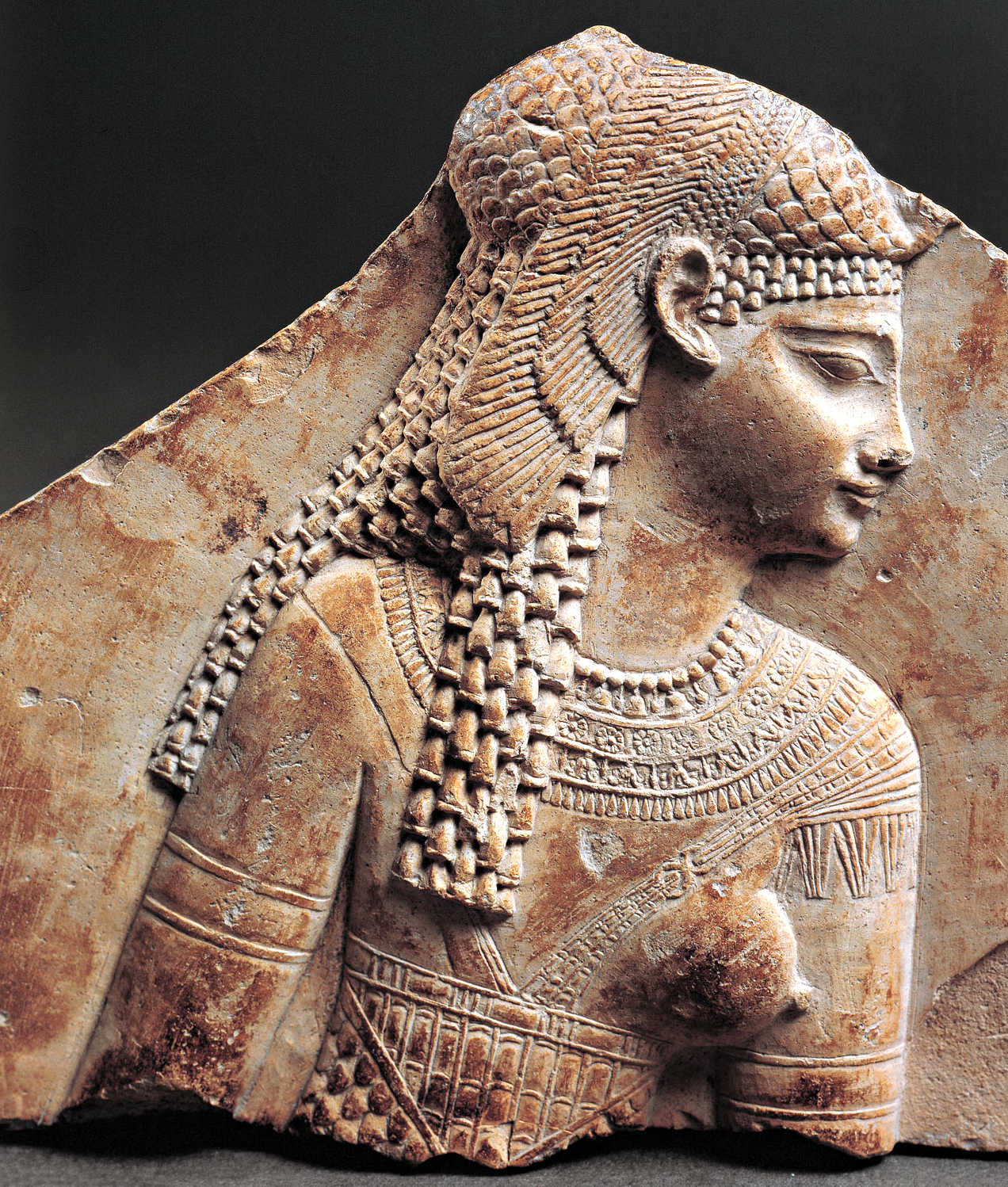
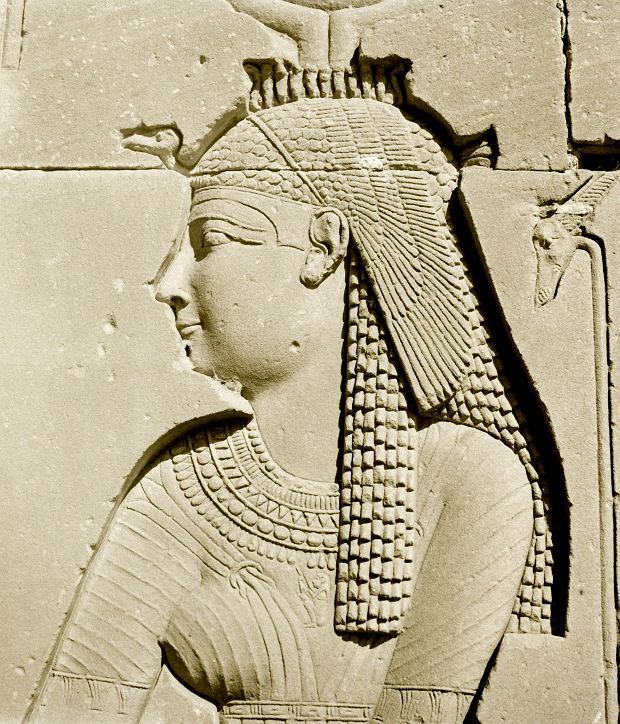
Cleopatra VII
Philopator was (for sure) the daughter of Ptolemy XII Auletes (80-52BC), Pharaoh of Egypt and
(quite likely) Cleopatra V Tryphaena. There is a marked difference in facial
features between the busts and temple relief's. The one thing the Egyptian
carvings have in common, are the bare breasts, a sign of fertility, as Isis. The signature tune of Egypt's
last Pharaoh Queen.
SIZE & BEAUTY
Cleopatra was not tall, in fact she was probably quite
small, and that may have been why her figure was so alluring.
A woman who is not particularly facially attractive to men
(in particular) will often view her desirability, sexually,
by how well proportioned her body is, and how a female
presents herself. And, writers of the day were mostly men.
There
can be little doubt that Cleopatra VII was theatrically
inclined and would have known that wearing see-through
garments would have aroused even the most impervious of men.
Powerful men, who already had wives or lovers, but had a
roving eye. Or just an eye for beauty. People are probably
correct, when they say that Cleopatra was smart and funny. On the other
hand, we are not convinced about the claim that Cleopatra wasn’t beautiful. She may not align with our modern American conception of what counts as “beautiful,” but ancient writers thought she was very beautiful. The ancient historian Kassios Dion (lived c. 155 – c. 235 AD), who was a Roman Senator of Greek origin, describes Cleopatra’s appearance in his Roman History 42.34.4–6. This is Dion's description, translated by Ernest Cary:
“For she was a woman of surpassing beauty, and at that time, when she was in the prime of her youth, she was most striking; she also possessed a most charming voice and a knowledge of how to make herself agreeable to every one. Being brilliant to look upon and to listen to, with the power to subjugate every one, even a love-sated man already past his prime, she thought that it would be in keeping with her rôle to meet Caesar, and she reposed in her beauty all her claims to the throne. She asked therefore for admission to his presence, and on obtaining permission adorned and beautified herself so as to appear before him in the most majestic and at the same time pity-inspiring guise. When she had perfected her schemes she entered the city (for she had been living outside of it), and by night without Ptolemy's knowledge went into the palace.”
Even Lucan, the Roman poet, who absolutely hated Cleopatra’s guts, still described as her as possessing “formam nocentem” or “fatal beauty.” If
Cleopatra wasn’t really beautiful, we would expect hostile authors like Lucan to make a big deal of this and lambast her for being ugly. Instead, they portray her beauty as dangerous. It’s really hard to make a case that Cleopatra wasn’t beautiful when even her worst enemies describe her as drop-dead gorgeous.
She may have had a large nose and frizzy hair, but who’s to say that means she wasn’t beautiful? When people today say that Cleopatra wasn’t beautiful, they're anachronistically imposing modern, western notions of beauty on a woman from over two thousand years ago.
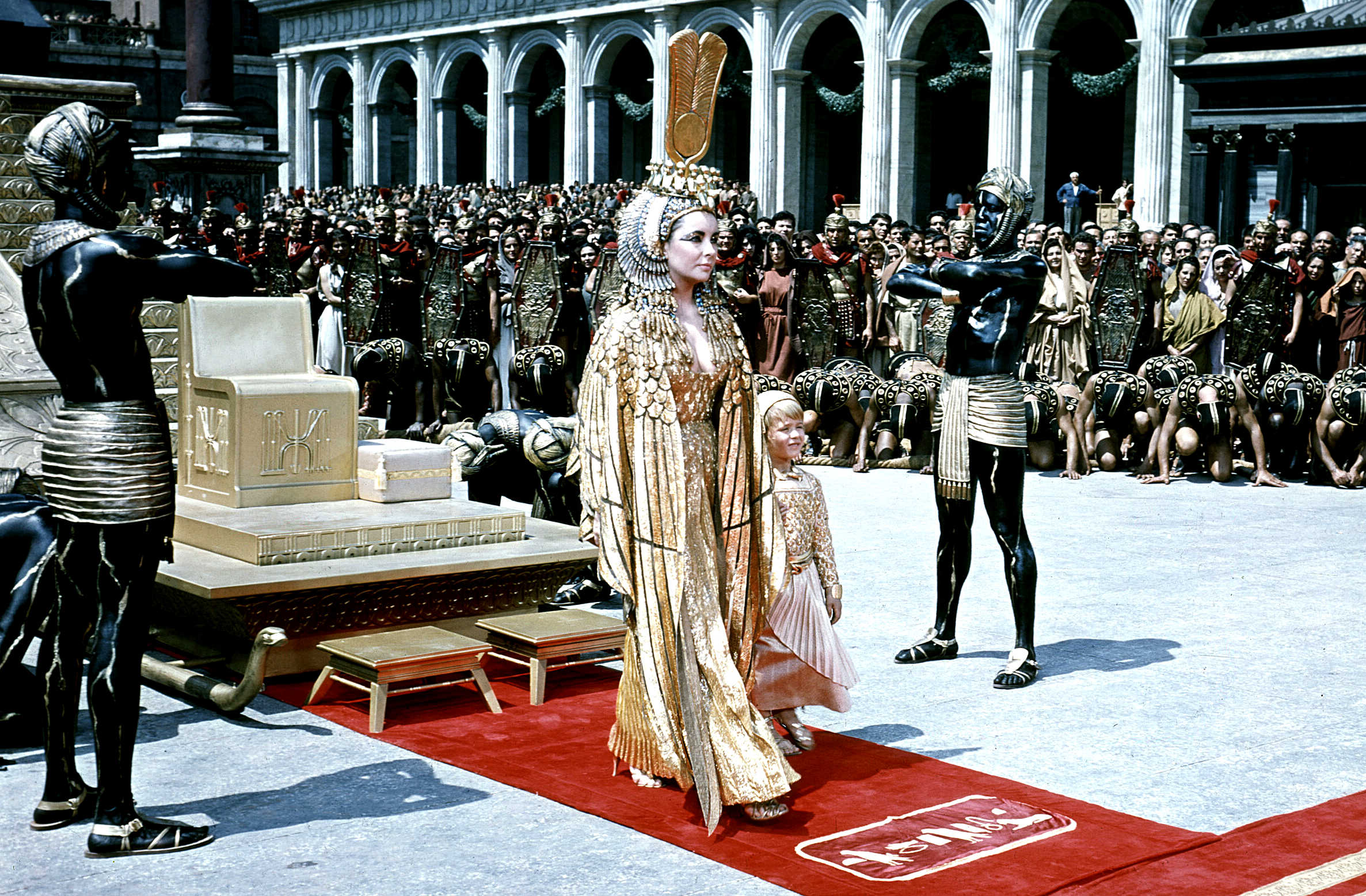
|






